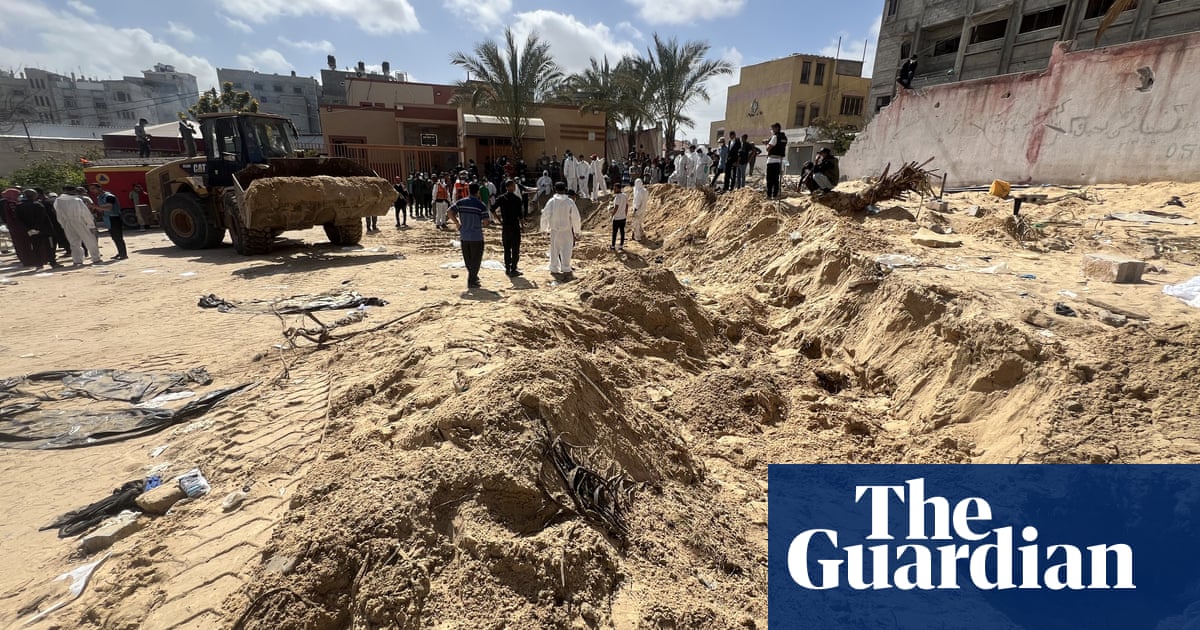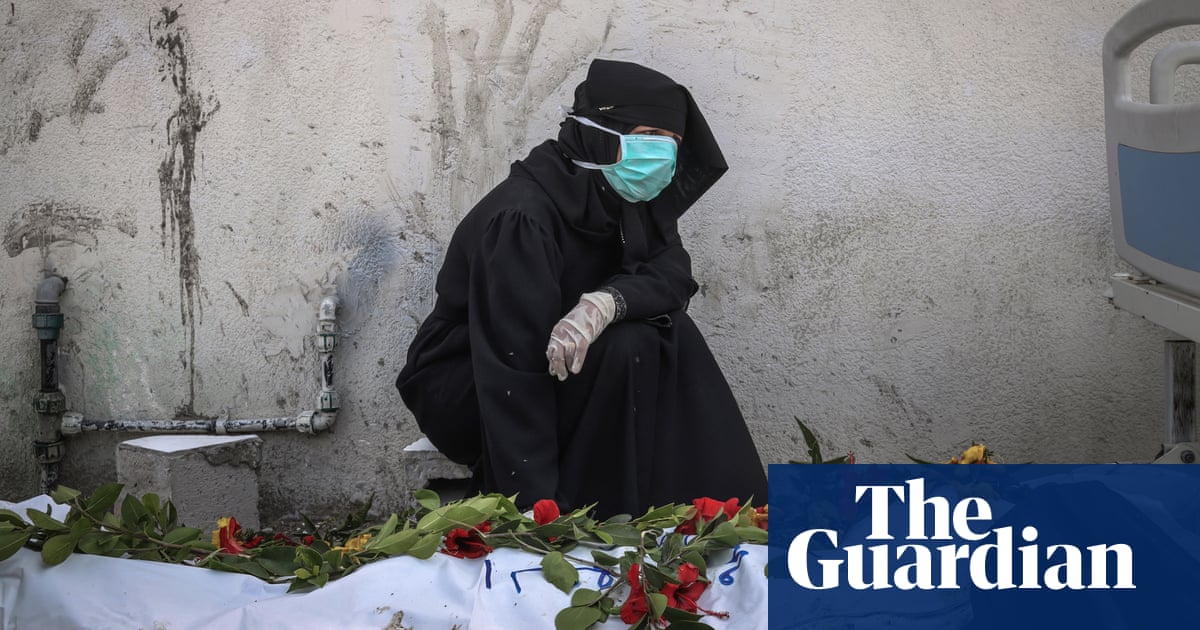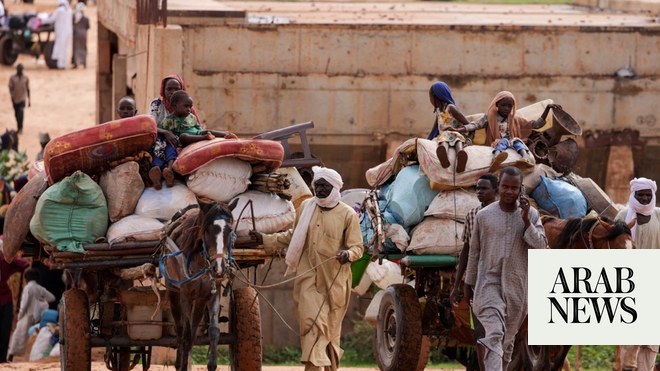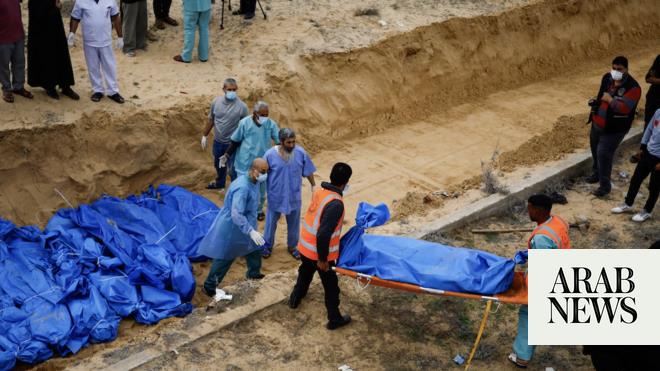
The UN human rights chief, Volker Türk, has said he was “horrified” by reports of mass graves containing hundreds of bodies at two of Gaza’s largest hospitals.
Palestinian civil defence teams began exhuming bodies from a mass grave outside the Nasser hospital complex in Khan Younis last week after Israeli troops withdrew. A total of 310 bodies have been found in the last week, including 35 in the past day, Palestinian officials have said.
“We feel the need to raise the alarm because clearly there have been multiple bodies discovered,” said Ravina Shamdasani, spokesperson for the UN high commissioner for human rights.
She described bodies “buried deep in the ground and covered with waste”, adding that “among the deceased were allegedly older people, women and wounded”, including some bound and stripped of their clothes.
“Some of them had their hands tied, which of course indicates serious violations of international human rights law and international humanitarian law, and these need to be subjected to further investigations,” she said.
Palestinian rescue teams and several observation missions from the UN also reported the discovery of multiple mass grave sites in the Shifa hospital compound, in Gaza City, earlier this month, after Israeli ground troops withdrew after a prolonged siege.
Medics working for Doctors Without Borders described how Israeli forces attacked Nasser hospital in late January before withdrawing a month later, leaving the facility unable to function.
Rescue workers are continuing to dig through the sandy earth to exhume bodies outside the hospital. Shamdasani said her office was working on corroborating Palestinian officials’ reports that hundreds of bodies had been found at the site.
Officials in Gaza said the bodies at Nasser were people who had died during the siege. Israel’s military on Tuesday rejected allegations of mass burials at the hospital, saying it had exhumed corpses to try to find hostages taken by Hamas in October.
“The claim that the IDF (Israel Defense Forces) buried Palestinian bodies is baseless and unfounded,” the military said, adding that after examining the bodies, its forces had returned them to where they had previously been buried.
Israel has repeatedly accused Hamas of operating in hospitals and using medical infrastructure as a shield, which Hamas denies.
The UN rights chief also condemned increasing numbers of Israeli airstrikes that have pummelled northern, central and southern Gaza in recent days, including naval artillery fire that has struck buildings along Gaza’s eastern shoreline.
Airstrikes hit many areas already reduced to little more than rubble and broken slabs of concrete after 200 days of war, including Beit Lahia in the north and the centre of Gaza City.
“The north remains dire,” said Olga Cherevko of the UN’s office for coordination of humanitarian affairs, speaking during a visit to the area. “There’s more food coming in, but there’s no money to buy it. Healthcare facilities destroyed. There’s no fuel to run water wells, and sanitation is a massive issue. There’s sewage everywhere.”
As Israeli ground troops reportedly staged a brief incursion into eastern Khan Younis, in the south of Gaza, satellite images from the destroyed city showed a growing tent encampment, which could be intended to house people fleeing Rafah in the event of an Israeli ground attack there.
Benjamin Netanyahu, the Israeli prime minister, has repeatedly threatened to attack Rafah, Gaza’s southernmost city, where more than a million people are sheltering. On Tuesday, Türk again warned against a full-scale incursion on Rafah, saying it could lead to “further atrocity crimes”.
Melanie Ward, the head of Medical Aid for Palestinians, who has recently returned from a visit to Gaza, said an Israeli invasion would be impossible without “human slaughter.”
Ward said that roads running north of Rafah approaching Deir al-Balah in central Gaza were already crammed with people.
“Every space … is already full of displaced people living in tents,” she said. “People who came from the east of Khan Younis can’t return there because their homes have been destroyed. That physically isn’t enough space for people in Rafah to try to move and seek safety somewhere else. It’s impossible for Israel to attack Rafah and for it not to be a disaster of epic proportions.”
Many of the recent strikes have hit parts of Gaza where people already displaced have fled for the third, fourth, or even fifth time.
“There’s no safe place to escape to, so everything we do, we try to do it fast,” said Rama Abu Amra, a 21-year-old student who sleeps with her family in a tent outside a friend’s house in Deir al-Balah, their fourth location since fleeing Gaza City months ago.
She said the tent was uncomfortable, hot by day and cold at night, and in a crowded area.
Asked where the family could flee in the event of an evacuation order, she said: “We honestly don’t know.”










